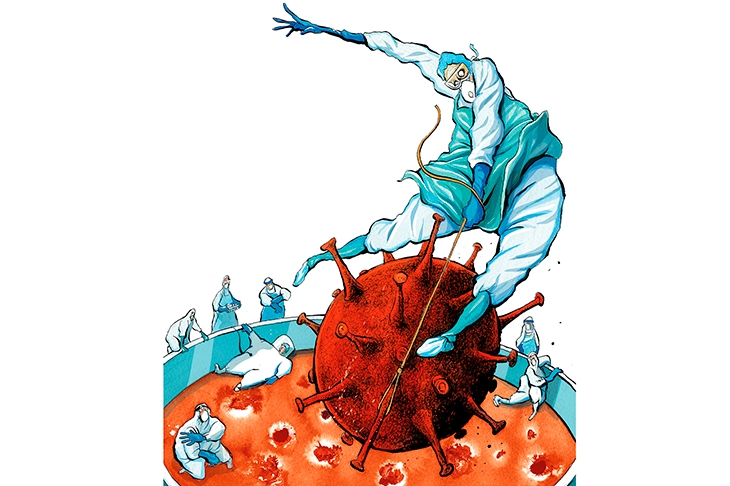What have we been witnessing these past few months? A worldwide crisis caused by the arrival of a new virus of exceptional virulence — or a crisis of awareness, in which incomplete information led to a wildly disproportionate reaction? Have lockdowns, face coverings and the rest saved millions of lives worldwide? Or have they had relatively little effect on the course of the pandemic, and ended up causing more harm than good? And why, so far, is Britain not seeing the surge of COVID-19 infections reported in Spain and France? What are we missing?
We still know a lot less about COVID-19, and about viruses in general, than you might have been led to believe. Viruses are older than mankind — and more numerous than all other forms of life put together — but we have only found out about them in the past century. And the sum of what we still don’t know is huge.
Why did you catch a cold yesterday, rather than last week, last month, or last year? Were you in contact with someone who had a cold or did you just happen to inhale the virus? Was it because you breathed in 1,000 viruses or just the one? Was it because it hit just the right cell, or because your immune system was out of kilter after a heavy night out? Was it because there was a critical imbalance among the other myriad pathogens in and around your body? The simple, truthful answer is that for most real-world cases, we have no idea at all.
It may help to view COVID from a radically different vantage point, and go back to the start of life on earth. Bear with me: what follows may help explain why I believe that much of what is said about this pandemic is either highly misleading or just plain wrong.
Coronaviruses are RNA viruses, and a widely accepted hypothesis suggests that RNA molecules pre-date life itself. In this view, an RNA world came first. RNA molecules can self-assemble, store information, and some (ribozymes) can facilitate other chemical reactions like protein enzymes. Ribosomes, a type of ribozyme which make proteins in our cells, are largely composed of RNA. Over time, DNA ended up replacing RNA as the main information-storage molecule because it is more stable and able to build longer proteins, which replaced ribozymes because their multiple amino-acid building blocks make them more versatile. Eventually cellular organisms appeared with DNA, RNA and protein molecules playing the roles now seen in all life.
The point is that no cell has ever existed which did not have to live alongside replicating RNA molecules, and, later, RNA viruses. It’s not unusual to have a new virus that’s out to get us. It happens all the time, in more ways than we have been able to measure. Every amoeba, every simple organism composed of a few cells, every fetus in its mother’s womb, every child, every adult, has to make their way in a world rife with independent RNA molecules following their own agenda. What’s more, because simpler microbes such as bacteria existed before us, we have always had to deal with them too. We are only just beginning to realize, through recent developments in science, how much our associations with these ‘simpler’ organisms matter. It’s also wrong to think of viruses only as a disease, or a threat.
Let me offer an example. Cells in our gut make mucus. Until very recently it was believed that the mucus acted simply as a physical barrier, preventing the bacteria that live in our gut from invading the cells of our bowel wall, where they could cause inflammation and disease. But it turns out that the mucus has evolved to host special types of viruses called bacteriophages, which infect and kill bacteria. For each of the trillions of bacteria in our gut there are about 40 bacteriophages in the mucus. So the mucus is not just a physical barrier, it’s a sophisticated bio-barrier honed to use viruses to protect us from bacteria.
It’s the same with our defenses against RNA viruses like COVID-19 — how can we judge the extent of the viral threat amid all this complexity? A lot of emphasis is being placed on the presence of antibodies: if you test negative then you’re at risk. This would be alarming if true, especially as the latest official figures show just 6 percent of Brits have tested positive for antibodies. But the real picture is, as so often, more complicated.
The main way we fight viruses is through T-cell responses, which kill virally infected cells. Interestingly, some studies have shown that up to 60 percent of people apparently never exposed to COVID-19 still had T-cells that reacted to the virus — suggesting that you might not need to have had this virus to have protection from it.
It’s a hugely important theory. But T-cell responses are harder to measure than antibodies, so they are not being widely tested for. There’s another recently discovered viral defense mechanism that operates entirely within cells: RNA interference (RNAi). If an RNA virus such as COVID-19 does manage to get inside a cell, special RNA molecules are made by the cell that interfere with and hinder replication of the virus. This crucial defense mechanism is not being tested for at all, yet it is clearly an ancient and vital part of how our bodies deal with RNA viruses such as COVID-19. Will it be important in explaining differing susceptibilities to coronavirus, or why it hits some people harder than others? Might this help explain why the pandemic curve has been the same in so many countries, irrespective of policies implemented? Almost certainly. What do we know about RNAi’s effects on disease in a population? Almost nothing.
Then we have the virus itself. Is this a threat far greater than other new viruses that have emerged in recent decades? We now have the tools to identify and follow new viruses. COVID-19 has followed a pretty typical viral infection curve in all countries — as far as can be determined from the limited measurements we have to date. A recent Swedish study of ‘COVID deaths’ outside hospitals found that only 15 percent of them died as a direct result of the virus. For most, there were other factors.
So it’s far from clear that COVID deaths are of a greater magnitude than a bad flu season. It has been argued that the virus would have killed half a million people in Britain had we not taken action. But how can any model be accurate given what we don’t know about COVID and how people respond to it? You don’t need to be a scientist to look at the number of cases of the virus in different countries and wonder why there is so little correlation with the actions they took. You might also notice the absence of any viral impact from the worldwide experiments of crowded BLM marches.
[special_offer]
Yes, we see a rise now in test positivity rates in some areas and, with it, talk of a ‘second wave’. But there is, as yet, no second wave in hospital admissions, in Britain or abroad. This suggests we are missing something fundamental. Could it be that the virus has significantly changed since the beginning of the pandemic? As I argued in these pages at the start of lockdown, RNA viruses change all the time and are likely to become less virulent with time. A recent study of 131 patients from Singapore has revealed a significant mutation: a less dangerous subtype of the virus with a shorter RNA molecule.
There is still so much we do not even begin to understand, but one thing has been clear for months: this virus is similar to other viruses we have lived with for generations. And there is very little evidence to support the benefits of the lockdown measures.
The case for returning to normal life is simple: the social, economic and public health costs of not doing so are far greater. With the COVID hospital cases in Britain now running at 96 percent below their peak, we can reasonably ask whether the overall situation might not be as bleak as we first feared and whether now is the time to get the world moving again.
This article was originally published in The Spectator’s UK magazine. Subscribe to the US edition here.


















